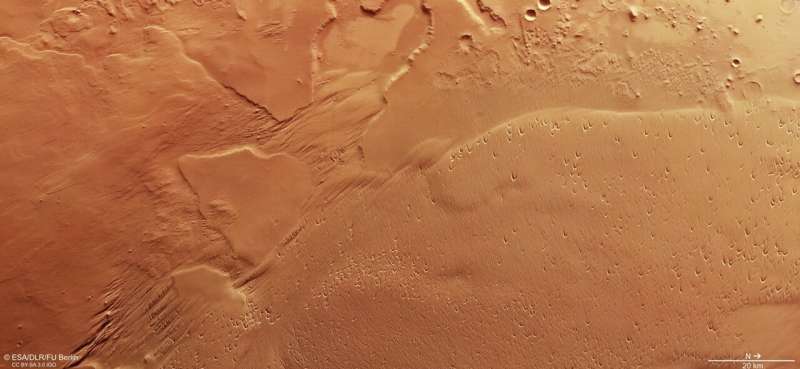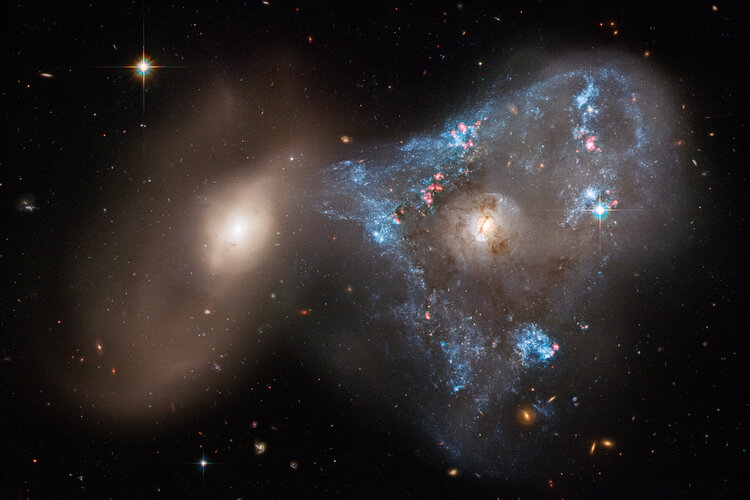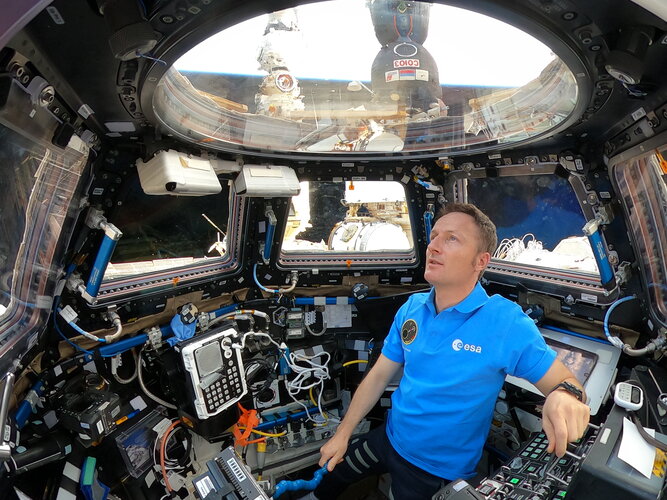
Copernical Team
James Webb Telescope adjustments bring stars more into focus
 NASA announced Friday that it completed another step in its alignment process of the new James Webb Space Telescope, bringing its test images more into focus.
The space agency said it completed the second and third of a seven-phase process to bring the telescope's 18 mirrors into proper alignment. NASA said it will now begin making smaller adjustments to the mirrors to make images even
NASA announced Friday that it completed another step in its alignment process of the new James Webb Space Telescope, bringing its test images more into focus.
The space agency said it completed the second and third of a seven-phase process to bring the telescope's 18 mirrors into proper alignment. NASA said it will now begin making smaller adjustments to the mirrors to make images even US-Russia tensions spill into space, but ISS safe -- for now
 Russia's invasion of Ukraine has placed a question mark over the future of the International Space Station, long a symbol of post Cold War cooperation, where astronauts and cosmonauts proudly live and work side-by-side.
The outpost was the subject of a menacing Twitter thread by Russian space agency head Dmitry Rogozin, who warned Thursday that US sanctions could "destroy our cooperation" an
Russia's invasion of Ukraine has placed a question mark over the future of the International Space Station, long a symbol of post Cold War cooperation, where astronauts and cosmonauts proudly live and work side-by-side.
The outpost was the subject of a menacing Twitter thread by Russian space agency head Dmitry Rogozin, who warned Thursday that US sanctions could "destroy our cooperation" an Here's what China is planning to do in space for the next five years

Central planning is literately central to any communist country, though its history has mixed results. As part of that planning, bureaucrats in all parts of the government are occasionally tasked with coming up with goals and milestones for their specific part of the government. These usually take the form of a five- or 10-year plan, which is what the China National Space Agency (CNSA) released on January 28.
This is the fifth such report, with previous releases in 2000, 2006, 2011 and 2016, and the current plans for future space exploration build on the efforts of the past plans. At more than 7,500 words, the document itself is hefty but still a relatively high-level overview of what the agency hopes to achieve. Some main focal points include improving the sustainability of their rocket launches, improving their global position system, partnering with Russia on lunar exploration, maintaining and expanding the Tiangong space station, researching the underlying technology for a Mars sample return mission, and building a global partnership to build a research station on the moon.
Wind-sculpted feature on Mars is an extensive dust factory

This image from ESA's Mars Express shows part of possibly the largest single source of dust on Mars: a wind-sculpted feature known as the Medusae Fossae Formation, or MFF.
The MFF is not only a veritable dust factory, but also remarkably extensive—it is the largest sedimentary deposit on the planet and stretches out discontinuously for more than 5,000 km, covering an area about the size of India. It is named for the Greek mythological Gorgon Medusa, who was able to turn those who looked into her eyes to stone, with the suffix 'fossae' being Latin for trenches or hollows.
The formation is found along the boundary between Mars' southern highlands and northern lowlands (known as the martian dichotomy), and sits between the planet's two most prominent volcanic regions (Tharsis and Elysium). It also contains the Eumenides Dorsum mountain range, the edges of which can be seen in the gentle elevation extending out of the bottom right of the frame (northeast).
Chinese rover finds translucent glass globules on the moon

Scientists say China's Yutu-2 rover, part of the Chang'E-4 mission, has found several small glass globules on the moon's far side. While tiny glass beads have been found previously in lunar samples brought back by the Apollo astronauts, the ones found by Yutu-2 are much bigger and translucent.
The discovery was made by Dr. Zhiyong Xiao, one of the lead scientific team members of the Chang'E-4 mission. They beads were found by looking at panoramic images taken by the rover. Since the rover doesn't have sampling capabilities and is not a sample return mission like it's older sibling, the Chang-E-5 mission, there is no compositional data on the glass beads, only observational evidence.
NASA rules out April for Artemis I launch, could target May

NASA mission managers updated Artemis I progress ahead of the March rollout of the massive Space Launch System rocket and Orion spacecraft to Kennedy Space Center's Launch Pad 39-B for what the agency calls a wet dress rehearsal.
While it's targeting March 16 at 6 p.m. for the 322-foot-tall rocket to make the 4.2-mile journey to the pad, the agency will need a month or more for testing and a rollback to the Vehicle Assembly Building before NASA signs off on a launch attempt. So an April launch window has been taken off the board.
"April is not a possibility. We're still evaluating the tail end of May," said Tom Whitmeyer, NASA's deputy associate administrator for exploration systems development. "But I want to be really careful once again, being straightforward with you. You know, we really need to get through this next few weeks here, see how we're doing."
The next possible windows for launch are from May 7-21, June 6-16 and June 29-July 12.
The majority of work inside the VAB is done ahead of the wet dress rollout, Whitmeyer said, including the last major hardware testing that involved the installation of the explosives on the vehicle that would be used in the event of an abort launch scenario.
Week in images: 21 - 25 February 2022

Week in images: 21 - 25 February 2022
Discover our week through the lens
100
 Image:
Image:
Happy 100 days in space to ESA astronaut Matthias Maurer. The first-time space flier marked the milestone on 19 February 2022 and what a busy 100-days it been.
In a Twitter post marking the milestone, Matthias wrote, “100 days may sound like a lot, but it feels like I've only just arrived.”
Even before launching for his Cosmic Kiss mission on a SpaceX Dragon as part of Crew-3, Matthias was on the science, providing researchers with pre-flight measurements for a variety of experiments.
Since arriving, Matthias has continued to be poked and prodded while working, exercising and even sleeping, all in
Cosmic flashes pinpointed to a surprising location in space
 Astronomers have been surprised by the closest source of the mysterious flashes in the sky known as fast radio bursts. Precision measurements with radio telescopes reveal that the bursts are made among old stars, and in a way that no one was expecting. The source of the flashes, in nearby spiral galaxy M 81, is the closest of its kind to Earth.?
Fast radio bursts are unpredictable, extreme
Astronomers have been surprised by the closest source of the mysterious flashes in the sky known as fast radio bursts. Precision measurements with radio telescopes reveal that the bursts are made among old stars, and in a way that no one was expecting. The source of the flashes, in nearby spiral galaxy M 81, is the closest of its kind to Earth.?
Fast radio bursts are unpredictable, extreme Ball Aerospace supports CDR of NASA's SPHEREx mission
 Ball Aerospace supported completion of critical design review (CDR) for NASA's Spectro-Photometer for the History of the Universe, Epoch of Reionization and Ices Explorer (SPHEREx) mission. Ball will now move forward with building the telescope and spacecraft.
In addition to designing and building the spacecraft and telescope, Ball Aerospace is responsible for conducting system integration
Ball Aerospace supported completion of critical design review (CDR) for NASA's Spectro-Photometer for the History of the Universe, Epoch of Reionization and Ices Explorer (SPHEREx) mission. Ball will now move forward with building the telescope and spacecraft.
In addition to designing and building the spacecraft and telescope, Ball Aerospace is responsible for conducting system integration 



































